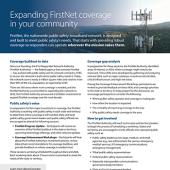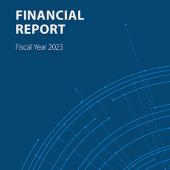This three part series explores some of the planning and preparedness help available from the FirstNet Authority, such as After-Action Reviews and the FirstNet Inject Catalog.
Whether organizing a sporting event, updating an emergency response plan, or responding to a weather-related disaster, first responders know that pre-event planning is crucial to ensuring a successful and safe outcome.
That’s why the First Responder Network Authority (FirstNet Authority) team offers advance planning and preparation support to FirstNet users. We work closely with public safety agencies to understand the event, identify first responders’ needs and desired capabilities for that day, and work with our network partner, AT&T, to identify what broadband solutions and coverage are needed to successfully support the event. As the number of FirstNet subscribers continues to grow nationwide, more public safety agencies are working with our team of experts and taking advantage of this unique and free service.
Off to the races
One such agency was the Department of Emergency Services (DES) in Sullivan County, Pennsylvania. The department worked with the FirstNet Authority in 2020 as it prepared for the annual World’s End Ultra Marathon — a 100-kilometer (63.8 mile) race best known for its rugged terrain and steep elevation gains.
“This is an annual event in which we face significant communication challenges: no broadband, limited cell and VHF radio coverage, and terrain only the race participants tend to embrace,” explained DES Director Joe Carpenter.
With this in mind, the race support team coordinated with the FirstNet Authority ahead of the race to ensure they had the communications tools they needed for the event. Through pre-event planning sessions, the FirstNet Authority team worked with supporting public safety agencies and race organizers to collect critical information about topics such as:
Public safety partners
The FirstNet Authority learned that the event would require interoperable communication among public safety agencies from both Montour and Sullivan Counties, some of which were not FirstNet subscribers.
Location and surrounding area
The FirstNet Authority explored the specific coverage challenges along the race course and surrounding areas in the World’s End State Park. Situated within an S-shaped valley, the park was historically prone to poor cell signal strength and spotty service.
Essential communications points
The FirstNet Authority learned that the race course would be outfitted with 12 aid stations staffed with mostly non-FirstNet users and volunteers. Stations that were designated to administer medical care or that were located near an emergency transport point were identified as essential communication points.
Identifying the right broadband solutions
After assessing the key details surrounding the event, the FirstNet Authority captured public safety’s input on specific communications challenges associated with the event and shared the data with AT&T to aid in decision-making.
Based on these initial planning efforts, AT&T deployed two FirstNet Satellite Cell on Light Trucks (SatCOLTs) to keep communications running smoothly throughout race day. In order to maximize area coverage, the FirstNet Authority worked with the DES team to discuss what constraints (e.g., park access, hours of operation, parking limitations, permitting requirements) existed and what additional resources (e.g., escorts, prior approvals, permits, fuel reserves) would be needed to deploy the FirstNet SatCOLTs. The FirstNet Authority shared this information with AT&T so they could determine the best positioning for the deployable assets.
Based on these advance planning efforts, AT&T also recommended lending FirstNet-enabled devices to the non-FirstNet users and volunteers so they could communicate via voice, text, and email on race day.
“The two SatCOLTs and cache of FirstNet phones provided capabilities and coverage for race operations not previously available,” said Carpenter. “FirstNet allowed Auxiliary Communications Services (ACS) personnel to focus on their core capabilities without interruption and allowed for improved resource allocation and more efficient operations.”
FirstNet keeps runners and responders safe
The DES team and other responding agencies saw the impact of FirstNet firsthand during the event—both for racer and responder safety.
When one racer did not check in at two successive aid stations, race support staff initiated efforts to locate him. Thanks to FirstNet, they had access to text capabilities in the field and were able to contact the racer on his personal cell phone to discuss his condition and location. They learned that the racer had suffered a sprained ankle and would be returning to race headquarters on his own.
In another instance, a member of the ACS team was having difficulty finding the location of an aid station. With his FirstNet phone and a mapping/tracking app, the command unit was able to direct him to the exact location of the station.
“FirstNet service allowed us to resolve operational issues that previously would have required significantly more resources to resolve,” said DES Director Joe Carpenter. “From an emergency management perspective, the applications for such services in the mountains of Pennsylvania are far reaching, and this experience has provided a real-world realization of the FirstNet capabilities available, even to a small rural Pennsylvania county.”
If you’re interested in discussing how to best integrate FirstNet services and capabilities into an event or emergency response plan, please contact me at Doug.Harder@firstnet.gov.




















